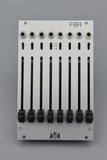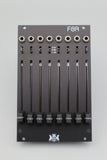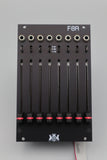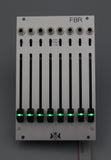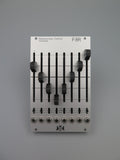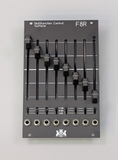*NEW* 2.1 Firmware! (Feb 2024)
- High Resolution mode for MIDI! 14bit Pitchbend on channels 1-8
Installation Notes: The new firmware must installed using the double-press of the reset button on the back of the module. The "reboot to bootloader" option on the editor is ONLY available for devices running 2.1 or later firmware. With the High Resolution mode enabled, BOTH TRS and USB MIDI send pitchbend on channels 1-8 and whatever CC mappings are assigned on the editor are disabled.
Download the 2.1 firmware New Feb 2024
Online parameter editor: https://misw.us/editor
To connect to the web editor, open the web page in a WebMIDI compatible browser, THEN connect the USB cable to the device. It will take several seconds to connect.
F8R is a 8 channel, 16hp control surface for Eurorack
Features:
- Long throw LED 60mm faders
- 0-5V, 0-10V, -5 to +5V CV ranges per channel
- Fully analog CV outputs
- I2C communications as leader or follower
- MIDI header for one output channel on the back of the device
- I2C, MIDI, and CV can be used simultaneously
- Available expander with additional midi and i2c outs
-
Dont forget to order an I2C/MIDI cable if you need one!
- Green LED for Natural Panel, Red for Black Panel
Expander Available which adds 3 Midi outputs, 3 I2C ports
I2C: Default State: Follower, Default Address: 0x31
16HP Width, 20mm Depth
Current Draw: +12V 50 mA, -12V 40 mA
Please Note:
This device uses PSIpower and has NO POLAIRTY on the power header, it can be installed EITHER WAY
Basic Usage instructions:
Front:
Voltage Select switches: Independent for each channel. Does NOT affect MIDI/I2C data
Rear:
Power Header: Standard 10pin power cable, there is NO polarity for this connection. It can be connected either way

MIDI Out Header: This is a 4 pin header but only 3 or 2 connections need to be used. To connect to a DIN cable, either GND, 5 (to pin 5, current sink/aka -), and 4 (to pin 4, current source/aka +) should be used. For internal module to module connections, only pin 4 and 5 should be used. The ground pin is only for the shield in a midi cable, it is never connected on a midi input and isnt necessary for the short module to module lengths

I2C Header: 3 pin header to connect to other I2C devices in your rack, this is an unbuffered connection so cable lengths should be as short as possible (20cm/6" recommended). There are 4.7k pull up resistors on this connection

Connector for Expander: This connects the F8R to the I/O expander. The cable is attached to the expander. Note the keyway at the top of the part, the connecter will ONLY connect one way
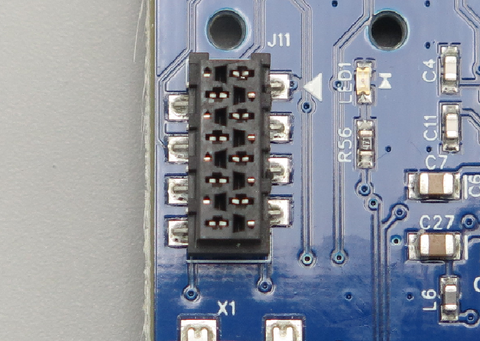
FIRMWARE UPDATES:
Current Firmware Version: 2.1
Firmware update procedure: Open the web editor, press the "Reboot to bootloader", a drive will appear on your computer, copy the UF2 file to that drive. It will close automatically
Firmware update procedure pre 2.1 firmware: Connect the Mini USB to your computer, power up the module via eurorack power and press the reset button on the back of the module twice (quickly). A new drive will appear on your computer, simply copy the firmware file to that drive (it will give you a warning about copying a file without properties) and thats it. The drive will disappear once the file is copied and the module will reboot with the new firmware.
The firmware is now unified for F8R and XVI, to identify the device as F8R, DIP switches must ALL BE OFF
THE DIP SWITCH IS NOW DEPRCIATED, ALL FUNCTIONS IT SERVED ARE NOW DONE VIA WEB EDITOR. Mid 2021+ Devices do NOT have this switch
IMPORTANT NOTE FOR USERS THAT DO NOT HAVE A RESET BUTTON ON THE DEVICE OR ARE RUNNING FIRMWARE VERSIONS LOWER THAN 1.0 (It says on the box), Please contact Michigan Synth Works for update procedure
Version History:
1.03 fixed midi channel on fader one set to channel 2
1.02 Migrated code to new bootloader
2.0 New codebase. Ardunio is no longer supported
2.1 Added High Resolution option for MIDI out
Open Source Licenses:
UF2 Bootloader designed by Adafruit Industries and released under the MIT License
Portions of the code used for this device come from the 16n Faderbank by Brian Crabtree, Tom Armitage, and Brendon Cassidy released under the MIT License











